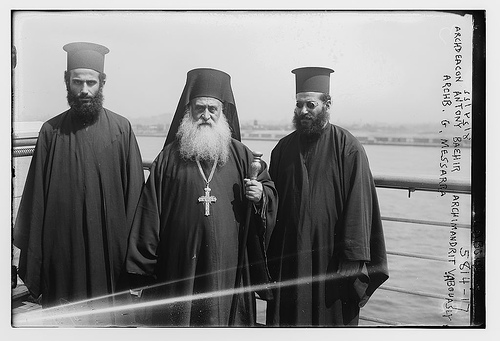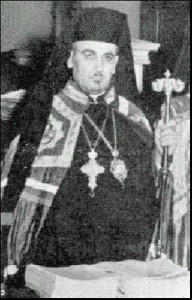
I haven’t done a great deal of research on Metropolitan Antony Bashir, and as a result, I’ve written very little about him on this website. That said, he is a hugely important figure in American Orthodox history. Today, February 15, marks the 44th anniversary of his death, in 1966.
Bashir arrived in America in 1922, as a 24-year-old archdeacon. He and Archimandrite Victor Abo-Assaley were accompanying the Antiochian Metropolitan Gerasimos Messara, who was ostensibly coming to the US to attend a convention of the Episcopal Church in Portland, Oregon. Soon, however, another agenda emerged: the establishment of an Antiochian Archdiocese in America. At that point, there were two factions of Arab Orthodox in America — the Russy, who were loyal to the Russian-backed Abp Aftimios Ofiesh; and the Antacky, who followed the rogue Antiochian Metropolitan Germanos Shehadi. Although he was from the Patriarchate of Antioch, Met Germanos was not supported that Church.
Into this chaos came Met Gerasimos Messara and his two lieutenants. It’s a long story which we’ll tell another day, but suffice it to say that, by 1924, Fr. Victor Abo-Assaley was consecrated as the first official Antiochian bishop for America. Bashir had been ordained shortly after his arrival in the US, in 1922. He spent two years in Mexico; I’m not sure why. I know he did translation work, but why would a young priest disappear to Mexico? Anyway, he ended up back in America, serving as a parish priest in Indiana.
In 1933-34, a remarkable thing happened: all of the many Arab Orthodox episcopal claimants suddenly vanished. Well, not exactly vanished, but, as a friend once put it, “God wiped the slate clean.” The first to go was Bp Emmanuel Abo-Hatab, the leader of the Russy faction, who died in May of 1933 (ironically, Met Germanos Shehadi officiated at his funeral). Abp Aftimios Ofiesh, who had previously led the Russy group and then sort of drifted off into his own little world, effectively ended his episcopate by marrying a young girl a couple of months after Abo-Hatab’s death. The same year, Met Germanos Shehadi finally left the country, returning to Syria, where he soon died. Abp Victor Abo-Assaley hung on the longest, dying in September 1934. And just to make things complete, Bp Sophronios Beshara, who said that he had inherited Ofiesh’s (already dubious) claims, also died in ’34.
So suddenly, what had been an incredibly complex ecclesiastical quagmire morphed into a claim-free simplicity. In 1935, the now-leaderless (and thus at least nominally “united”) Antiochians held elections for a new hierarch. The top two vote-getters were the still-young (37-year-old) Archimandrite Antony Bashir, and a Toledo archimandrite named Samuel David. Bashir got the most votes, but a strong minority favored Samuel David.
To put it plainly, both men were consecrated as bishops on the very same day in 1936, Bashir in New York, David in Toledo. The story is so complicated that I won’t even try to explain it. Bottom line, the American Antiochians were still hopelessly divided, with the result being the establishment of two overlapping Antiochian Archdioceses, one based out of New York, the other Toledo. This “Toledo-New York schism” would last until the 1970s.

As for Bashir, he was a fascinating man. Intellectually brilliant, he was an accomplished translator and scholar. He was a strong proponent of Orthodox unity in America, and was one of the driving forces behind the formation of the short-lived Federated Orthodox Greek Catholic Primary Jurisdictions in America (or, more palatably, “the Federation). As we’ve discussed here already, the Federation was essentially a proto-SCOBA body. When it collapsed in 1944, Bashir kept it alive on life support. Into the 1950s, he was still listed as the head of the Federation, even though it did not, as a practical matter, exist at all. When SCOBA was formed in the early 1960s, Bashir was again a central player.
He also advocated the use of English in church services. Under Bashir, the convert priest Fr. Michael Gelsinger gained a great deal of influence, and numerous converts joined the Antiochian Archdiocese. Bashir founded the modern-day Word Magazine (the original Al-Kalimat having ceased publication long before; in reality, the two publications are totally distinct aside from their names). He started SOYO, the Archdiocesan youth group, as well as the Western Rite Vicariate. Many of the most distinct features of the Antiochian Archdiocese today can be traced to Bashir.
Bashir died in Boston on February 16, 1966, a month shy of his 68th birthday.
I don’t think Metropolitan Antony Bashir was a saint, by any means. But if there is ever a Hall of Fame for American Orthodoxy, he would certainly belong in it.
Comments
4 responses to “Today in history: the death of Metropolitan Antony Bashir”
“He spent two years in Mexico; I’m not sure why. I know he did translation work, but why would a young priest disappear to Mexico? ”
Why would going to Mexico mean “to disappear?” There was, and is, a large Arab Mexican community (the birthplace, for instance of the Modern Arab writer Albert Adib). St. Raphael had also visited Mexico as part of his duties in the Russian Mission.
Isa,
That was just a poorly-worded sentence on my part. I didn’t mean to imply that Bashir intentionally “disappeared” to Mexico, or something. It’s just that, I’m aware of the fact that he went to Mexico, but I don’t know what exactly he was doing down there. Most likely, you’re right — he was probably serving the Arab Orthodox there.
My apologies for the misleading sentence.
[…] latest podcast is up at AFR. I discuss the life of Metropolitan Antony Bashir, basically repeating what I wrote a month ago, on the anniversary of his […]
[…] Metropolitan Antony Bashir was the head of the Antiochian Archdiocese of New York from 1936 until his death in 1966. He said the following in an interview published in the Brooklyn Daily Eagle, February 4, 1939: […]